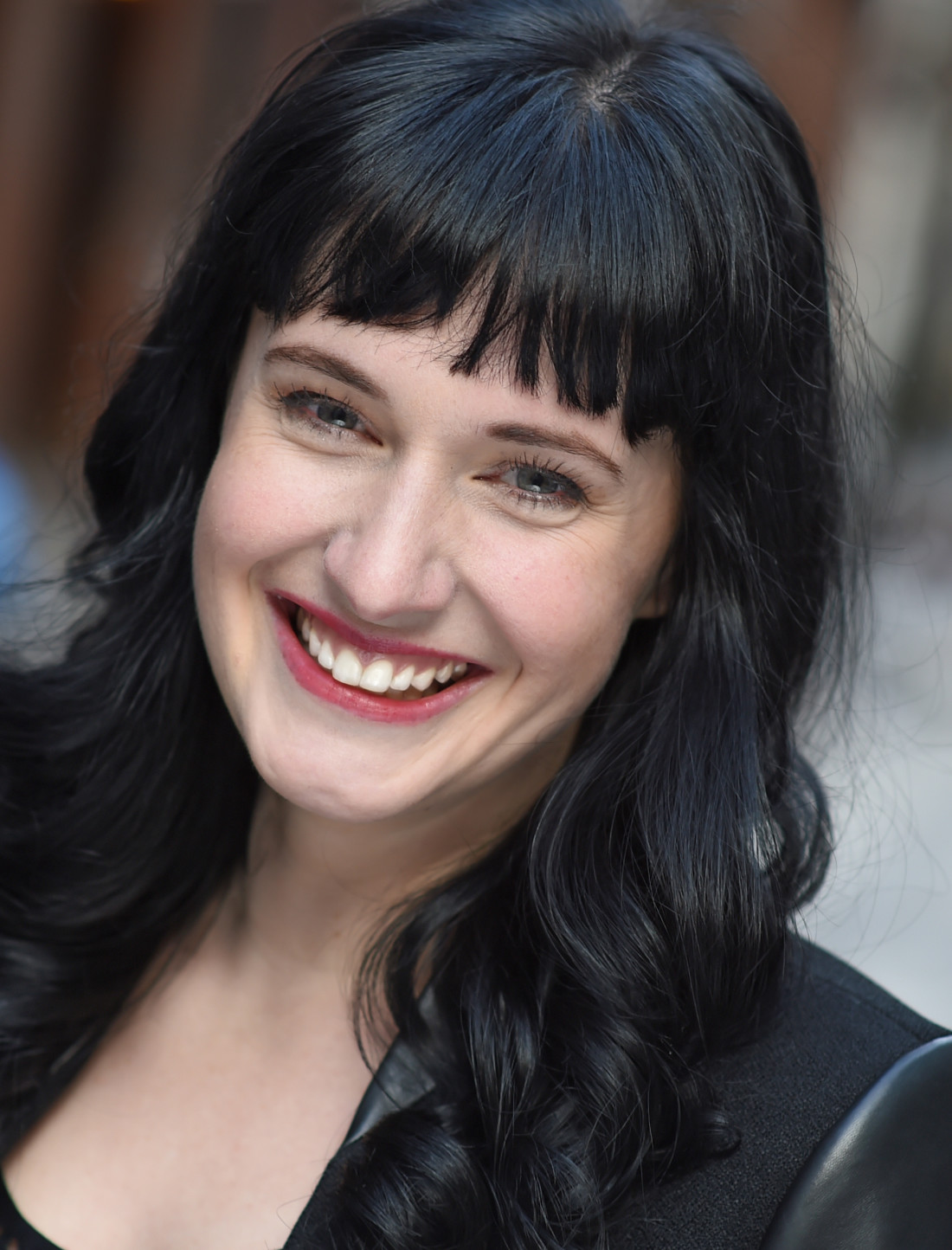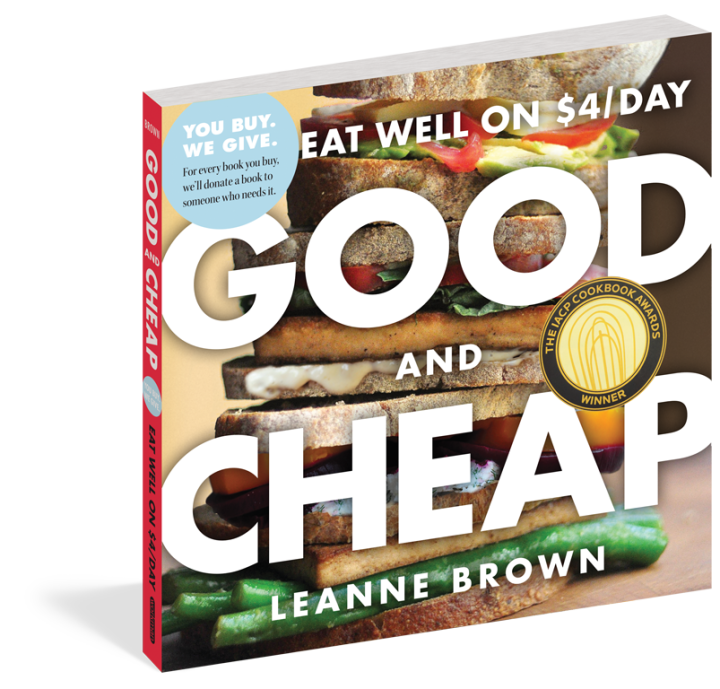Leanne Brown originally developed Good and Cheap: Eat Well on $4/Day as the thesis project for her master’s degree in food studies. A Canadian studying at New York University, Brown became aware of the problem of food insecurity while learning about Supplemental Nutrition Assistance Program, or SNAP, which only provides about $4 per day for food for its recipients. Inspired, she set out to see how well one could eat on such a tight budget.
The resulting book, which she describes as more of a “strategy guide” than a cookbook, offers a colorful yet approachable selection of recipes that can be made on a $4-per-day budget and encourage the use of readily available, nutritious, seasonal foods. The book also aims to empower and educate readers with tips on stocking a pantry, shopping on a budget, using up leftovers and more.
After the PDF of Brown’s graduate project went viral online, she launched a wildly successful Kickstarter campaign that allowed her to fund a 40,000-copy print run of the current edition through Workman Publishing. For every copy of the book that is sold, the publishers donate a copy to someone in need.
Brown will help kick off Hunger Action Month in Western North Carolina with book signings and food demonstrations on Thursday, Sept. 4, on the YMCA Mobile Kitchen at Pisgah View Apartments in Asheville and City Lights Bookstore in Sylva. Xpress recently spoke with her to find out more about her book and what she’s learned about eating well on very little money.
Mountain Xpress: Can you talk about how your project began?
Leanne Brown: I started working on it in earnest in April 2013. I ended up doing a bunch of volunteer work for a program of Share Our Strength called Cooking Matters, in particular doing grocery store tours where, basically, I would go to Bushwick, Brooklyn, everyday and hang out at the WIC center [WIC is the Special Supplemental Nutrition Program for Women, Infants, and Children] there and try to convince families to come on a grocery store tour with me. I basically would go to the store hoping to learn about some challenges facing these families — what is hard about eating well on a budget and things like that — and I learned so much from doing these tours. And what would really break the ice is when we started to talk about foods people like and what they like to make with them. People would always get the most excited about that; like people would say like, ‘Oh, eggplant — what can I make with that?’ … It was meant to be sort of a nutrition workshop, but I always found people were much more receptive to celebrating the good foods that you can make and talking about ways to save money on the foods that you want to get.
Being from Canada, was this your first experience with WIC and food stamps?
Yes, it was. I mean, in Canada we are so steeped in American culture, and yet we are completely different. There is no WIC program and no SNAP program in Canada, and so [it was interesting] studying these sorts of programs intensely alongside other issues; they are a huge part of what makes the food system what it is in the United States. I think that actually my interest in SNAP and WIC and all of that comes, to some extent, from just being Canadian. I think that when you grow up with it, it seems more normal, whereas I was a bit more questioning of it and a bit more curious about it because it was new to me. Canada is a very, very big country but we’re not very populated. Right now there are between 46 and 47 million people who are living on SNAP, and there are only 35 million people in all of Canada. It’s really amazing to me how many people are living here on such a small amount of money.
What kind of response have you heard from food-insecure populations?
I’ve heard from so many people in so many different situations, and really extraordinarily touching things. … My favorite story that I like to tell people is about a woman named Brenda. We spoke quite a lot last summer during the Kickstarter campaign for the first edition of the book — she read about it somewhere and wrote to me. She’s a grandmother living in this very small town, and she takes care of her two young grandchildren … raising them on her retirement income. She initially told me she was trying to cook and really working on feeding the kids better and getting her own health in shape so she can be there for them as much as possible. She said it was tough because even though they get SNAP assistance, they often have to go to food pantries at the end of the month, and that the food pantry is a great thing, but unfortunately they hand out really sugary, processed stuff, which she doesn’t want to feed her kids. So she started planting a garden, and then around Easter of this year she reached out again out of nowhere and we got to talking again … and then she dropped this total bomb on me and told me, ‘In the last few months, we’ve been able to totally live within our means, we haven’t had to go to the pantry, I’ve lot 30 pounds and I’m off my cholesterol medication.’ I don’t think Good and Cheap can take credit for all that, but I think it’s that she’s made this decision to eat better, and it’s what eating well can do for you. It doesn’t have to be this big diet plan. You can make yourself healthier and improve your life just by making a few simple decisions, and those things can be very powerful.
Where did you get the ideas for the recipes in the book? Are these all things you make for yourself at home?
Oh, yes, of course! Everything in there I made and photographed in my little apartment over that year or so, and then I continued to add recipes. And this was my thought: Let’s try to make things that people may not have thought about making and share things that everyone should know how to do. And I tried to express that you can always make them your own in slightly different ways. When [the Kickstarter project] went viral on Reddit, I talked to more and more people, and I just really wanted to open the door wider and wider and wider. What I wanted from the book was for everyone to hopefully recognize something of themselves, their tastes, their families in a few of the recipes. I wanted to make it as wide as possible, because people are in such different situations — people living on their own, people with families or in multifamily households — I wanted them all to find food that they could make work and that they’re excited by.
What are some of your favorite recipes from the book?
I make things from the book all the time. I make the kale salad constantly when kale is in season, and right now I’ve been making a lot of things with tomatoes and zucchini because that’s whats fresh at the moment. As for what’s personal, in the new book, the tomato soup and grilled cheese is probably the most classic of my family’s recipes. One of the first things I remember making was a can of tomato soup when I was like 12 or something. Then when I grew up I realized I could just use canned tomatoes and maybe a little bit of cream or broth, so I was making it myself and it wasn’t just this weird gelatinous blob. And grilled cheese sandwiches are sort of a goofy thing to have in a cookbook, and I was almost self-conscious about putting that in there, but I thought, ‘This is my soul food; this is what my family loves.’ … And I think that’s true of most people; most of us most of the time just want really simple food. And I think that’s a wonderful thing to celebrate and to realize that food doesn’t have to be complex most of the time to be enjoyable. The things that are our favorites can actually be really easy and simple to make.
It seems that throughout the book, in addition to encouraging readers to work with ingredients that are readily available and cheap, you also urge them to be resourceful and flexible and use whatever they already have on hand.
Yeah, I think you have to be. Cooking is a necessity, but I wanted to flip things over so necessity can become a fun, creative endeavor. So much of thinking you’re a bad cook or being afraid to get started with it is fear. People are intimidated by cooking. … But basic cooking, like getting food you will really like onto your table, is something we’re all totally capable of, and we don’t have to be intimidated. You don’t have to have the perfect meal, you just have to have some food that you’re going to like. And nine times out of 10, if you use basic ingredients that are whole and prepared simply, you’re actually going to be blown away by how good it is. Basic whole foods taste great on their own. I mean, just add enough salt, and you’re good.
As a student, you were very interested in food systems and policies. What do you think people can do within their communities to create environmentally sustainable food systems?
I think it really does go beyond individual choices. I think individual choices make us feel good, and they do matter, and they are great experience for moving forward, but I think that people need to get organized collectively and ask the government for things and vote. Systemic change is the only thing that is going to make big, lasting differences. Things like the cuts that are proposed to the SNAP program — I think over the coming years that’s only going to continue. We have to really get together and say, ‘These things matter to us. This is an investment in human beings.’ … At the basic level it’s going to look like growing local food movements, supporting our farmers and trying to create as many avenues as possible for them to sell their wonderful food to as diverse an audience as possible, and just making sure that everyone is at the table — inviting people who are different from you to talk, to try to have as diverse a coalition as possible. That way we can move forward with changes that will be good for everyone, or at least palatable for everyone.





where can I order leane browns new book?
Hi, Duane. Good question! Good and Cheap is available at most local book stores, and you can order it from Amazon.com. The PDF can also be downloaded for free http://www.leannebrown.com/.
http://sniegozmones.lt/robertomjunior/f2661-71393-103.htmlティファニーで朝食を 小説,ティファニー 指輪 ハート,ポーター ショルダー,ポーター コラボ トート,【新品-本物-正規品】最低価格と最高の品質を持つ製品は超激安 価格で大 放出!ニナリッチバック
ティファニー ブレスレット ペア,ティファニー ピアス ブログ,ニナリッチ 香水 マカロン http://www.achrh.org/robertomjunior/e3bfd-11389-74.html
http://www.barcelone-tanger.com/robertomjunior/e8a1e-31390-83.htmlティファニー 食器 グラス新宿,少女時代 ティファニー 日本語,ニナリッチ 財布 二つ折り
ティファニー 店舗 アウトレット,ティファニー 指輪 婚約,ニナリッチ 財布 小銭入れ http://bestarmworkouts.com/robertomjunior/d9fbb-71387-59.html
http://ipixellete.com/robertomjunior/d0379-31385-42.htmlティファニー 指輪 芸能人,ティファニーで朝食を 漫画,ニナリッチ 時計 修理
少女時代 ティファニー 体重,ティファニー ピアス シルバー,ニナリッチ ハンカチ http://www.undertheshield.com/robertomjunior/cb557-11383-33.html